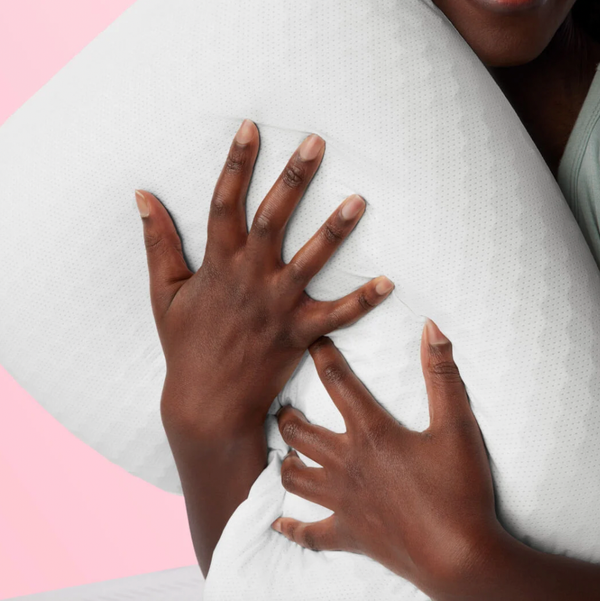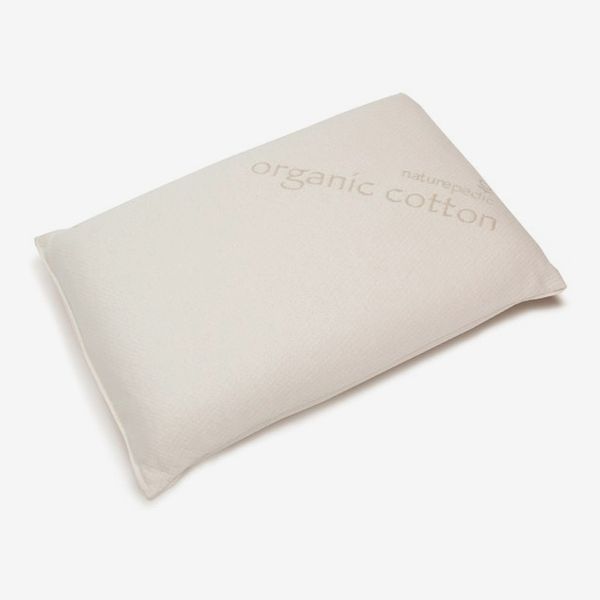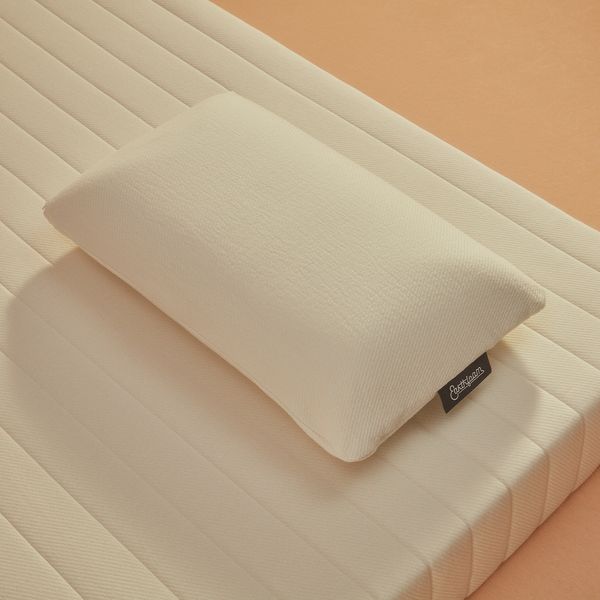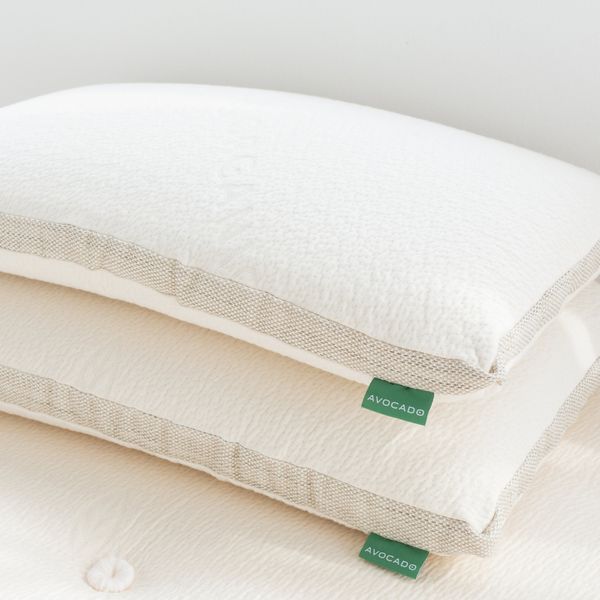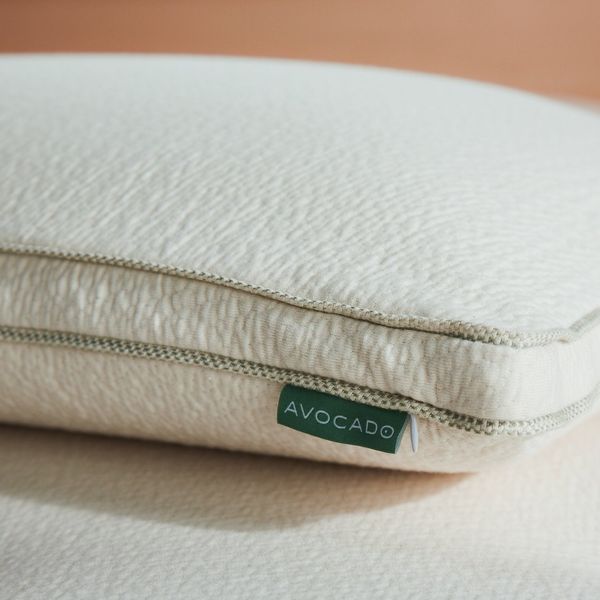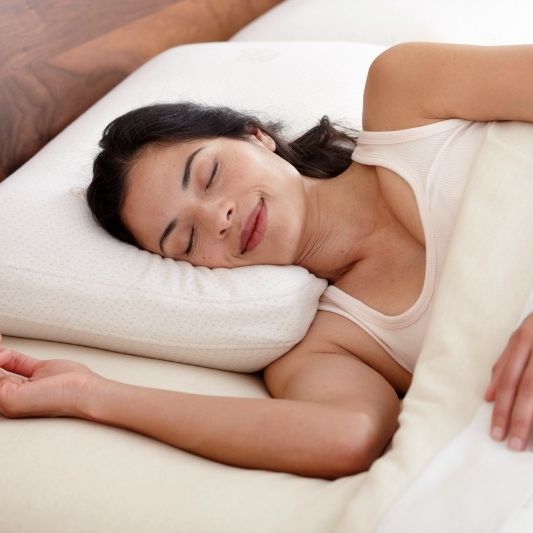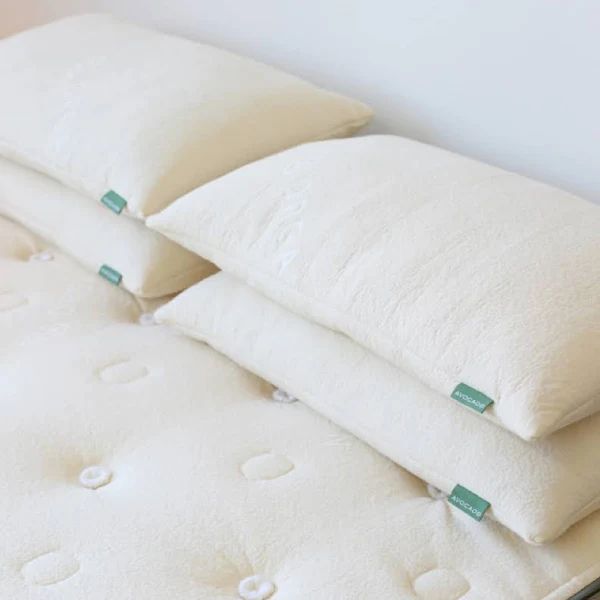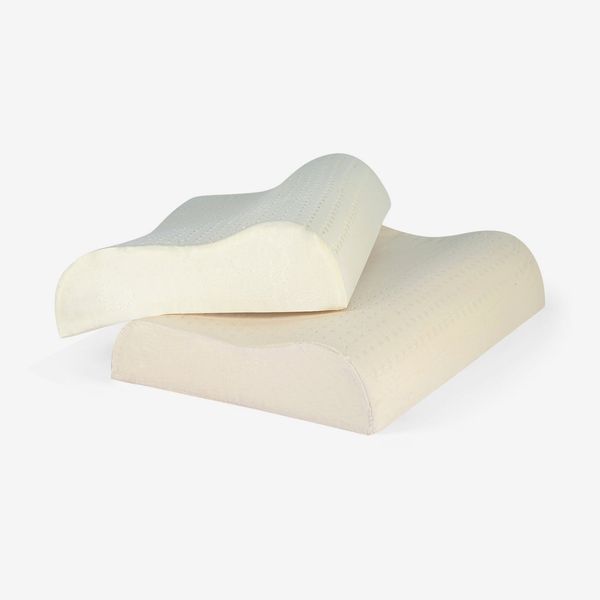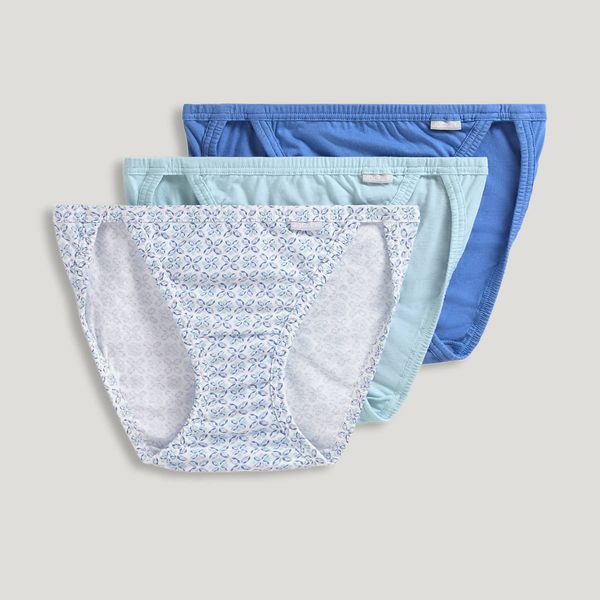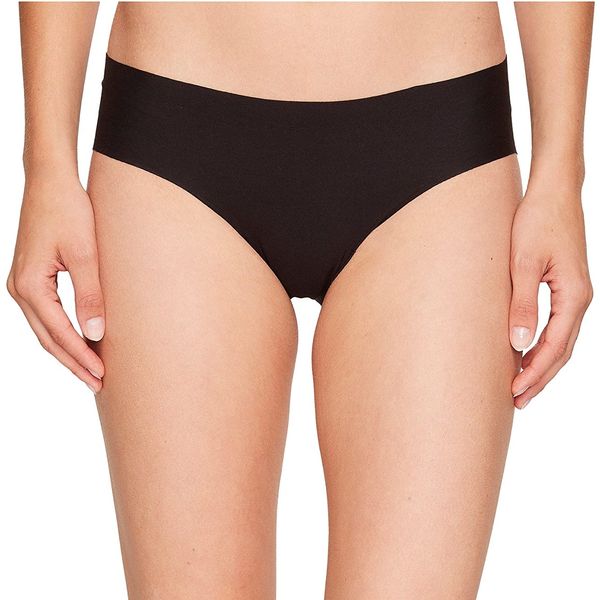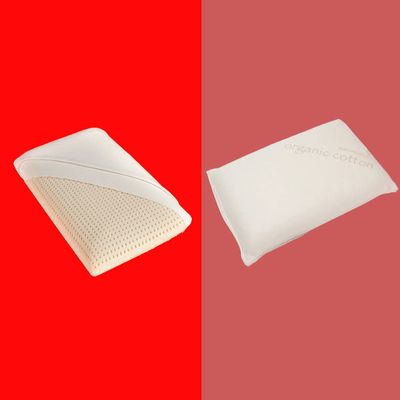
In this article
Cards on the table: I love latex pillows. I like how latex is springy, rather than dense and slow-sinking like memory foam (though I can still appreciate a good memory-foam pillow). And I like how it tends to stay cooler than memory foam. Latex does run more expensive than many other pillow styles, however — I’d expect to spend around $100 on a quality one. Having primarily slept on a latex pillow for the better part of the last year, I can confidently say they just work for me — and they can work for a lot of other people too. Dr. Thomas Pontinen, co-founder of MAPS Centers for Pain Control, told me he finds latex pillows much more accommodating to a variety of body types than memory foam and frequently recommends them to patients who struggle with sleep because they are both supportive and cooling.
Latex pillows are made from latex foam — broadly speaking, a type of foam made from the sap of rubber trees. It’s essentially the same stuff that rubber and other latex products (like gloves or makeup prosthetics) are made of, but processed differently to produce a foam.
Latex foam is often touted as an ecofriendly alternative to memory foam, since memory foam is, at the end of the day, basically made from plastic. If that ecofriendliness is important to you, you’ll want to pay extra attention to whether or not your pillow is made from natural or organic latex — there are synthetic latexes that, like memory foam, are made from petrochemicals. All the pillows on this list are made from natural latex, but there are synthetic ones out there.
To find the best latex pillows, I consulted three physical-health experts for their recommendations, as well as asking the Strategist staff for their favorites. I also tested ten pillows myself, taking loft and firmness into consideration — as I do when trying any style of pillow — because these two factors determine a lot about how comfortable a pillow is and what kinds of sleepers might like it best. I also looked at what type of latex each pillow is made from, whether the latex is solid or shredded, and whether it has any certifications that confirm it has been sustainably and ethically produced. I’ve listed my resulting picks for the best latex pillows below — or, if you think you might prefer another pillow type, take a look at our guide to the all-around best pillows.
What we’re looking for:
Type of latex
Broadly speaking, latex can be natural, synthetic, or blended. Natural latex is derived from rubber-tree sap, while synthetic latex is derived from petroleum by-products. Blended latex is a mix of the two. It’s unlikely you’ll notice a big difference in feel and performance between natural, synthetic, and blended latex. However, many people prefer natural latex as a way to be more environmentally friendly, since it comes from a renewable source.
Additionally, there are two primary methods of latex-foam production: Dunlop and Talalay. The primary difference between the results of these two methods is that Dunlop latex tends to be firmer and denser than Talalay latex, which tends to be fairly soft. I’ve noted what type of latex each pillow is made with when the brand has provided the information.
Certifications
If you want to be sure your latex pillow is made of natural latex and manufactured in as environmentally friendly a way as possible, there are a few certifications to look for. The first is the Global Organic Latex Standard (GOLS), which means the sap used to make the latex is sourced from organically grown trees. It also requires the final product to be 95 percent natural latex, with a maximum of 5 percent processing chemicals and fillers (something all latex foams have). Another important one is issued by the Forest Stewardship Council (FSC). Since rubber comes from trees, latex foams can be FSC certified, meaning the trees are grown and harvested responsibly and workers are treated fairly. Additionally, latex foams can be eco-INSTITUT certified to be low-pollutant and low-emission. There are other certifications that apply to latex as well, such as Greenguard Gold (which covers emissions), Fair for Life (fair trade), and so on. Many latex pillows have additional certifications for their other components (like a cover or additional filling), but to keep it simple, I’ve only listed the latex-specific certifications for each pillow in this guide.
As for how much these certifications matter, it kind of depends on your priorities. If you are buying latex for the purpose of buying a “natural” or more ecofriendly product, then I would pay close attention to certifications — though it’s important to keep in mind that all latex foams are made with foaming agents and additives to make the liquid sap into foam, even if they are made with natural or organic latex. And I don’t think a pillow is necessarily low-quality because it lacks organic/natural certifications, as they often pertain more to the production process than the final product. If you are most concerned about health/safety of the final product, the certifications covering emissions and volatile organic compounds (VOCs) will be most important.
Solid vs shredded
Latex generally comes in two formats for pillows: slab or shredded. Neither is necessarily better or worse — it just depends on your preferences for firmness and feel. The biggest difference will be that a shredded-latex pillow is more moldable, since the filling is a bunch of small pieces. You’ll be able to squish and squash it around the way you can with a down pillow, whereas a single slab of latex is a uniform block of foam that holds its shape.
Loft
Loft is pillow terminology for the height of a pillow, and it plays a big role in how well any given pillow will support your neck. A pillow that’s too lofty might cause neck pain, but a pillow that’s too low might not provide enough support. The right loft for you will depend on your primary sleeping position, as well as your body size — people who are more petite or who have narrower shoulders will need a lower loft and people with larger bodies or broader shoulders may need a higher loft. Generally, side sleepers need a high loft, back sleepers need a medium loft, and stomach sleepers need a low loft to properly support their neck and keep their head, neck, and spine in a neutral position. For each pillow in this guide, I’ve listed whether the loft is low, medium, or high (or if it comes in multiple heights). I generally think of two to three inches as low loft, four to five inches as medium loft, and six inches or more as high loft.
Firmness
Similar to loft, firmness will play a big role in how well a pillow works for you. Personal preference is definitely important, but as a general rule, I always recommend firmer pillows for side sleepers, medium-firm pillows for back sleepers, and softer pillows for stomach sleepers to help keep their necks properly aligned. Latex foam can range from soft to firm — just keep in mind that it will almost never be as soft as materials like down or fiberfill, since it is still foam.
Best latex pillow overall
Latex type: Slab of Talalay latex | Certifications: Clean Air Gold | Loft: Low, medium, or high | Firmness: Medium
When I first started reporting this story, I was on a bit of a mission to see if I could find a latex pillow that topped the Purple Harmony. I’ve written about this pillow quite a bit, including naming it our best pillow for back sleepers. The Purple Harmony has been my primary pillow — meaning the one I sleep with when I’m not testing other ones — for over a year, and I still love it. It has a Talalay latex core and a thin layer of Purple’s proprietary GelFlex grid with a mesh cover. The combo of Talalay latex and the Purple grid gives this pillow a really bouncy and springy feel. It is soft and flexible, but still offers plenty of neck support. It also comes in three lofts, which is part of why I picked it for the top spot. You can choose between low (5.5 inches), medium (6.5 inches), and tall (7.5 inches). I have the low-loft version, and it’s ideal for me — I mostly sleep on my back and side, and I tend to prefer a not-too-lofty pillow. Arguably, I’d say 5.5 inches is more of a medium loft than truly low, but because the foam is soft and pliant, it compresses slightly beneath my head when I’m lying on it, so the loft gets slightly lower. In addition to the three loft options, the Purple Harmony also comes in both a standard and a king size.
The Purple Harmony also seems to have a bit of a cult following. Two experts I spoke to recommended this pillow by name, and anecdotally, I know quite a few people in my life who love it. My partner sleeps on this pillow and loves it — as does his mom, who bought it based on my recommendation. I even recently spoke to a salesperson at a brick-and-mortar mattress store who told me this was her favorite pillow.
No doubt this pillow is pricey. But I decided it deserved the top spot after I tested all the other pillows in this guide and many of them were in a similar price range, if not more expensive. Latex is a more expensive material than, say, memory foam, so the prices generally are higher for the entire product category. And for what it’s worth, I think the Purple Harmony is a very durable, long-lasting pillow. My partner and I have had ours for over a year and they are still in great shape — no real signs of wear and just as springy as ever.
Another potential caveat is that the Purple Harmony is lacking in certifications compared to most of the other pillows on this list. It’s definitely not the most natural or ecofriendly pillow (the GelFlex grid is essentially plastic), so if that’s your priority as a latex-pillow shopper, it may not work for you. But I don’t think ecofriendliness is the sole reason to buy a latex pillow (the material offers a unique feel compared to polyurethane foams), and because this one stands out in feel, cooling, and versatility, it stands as my top pick.
Best (less expensive) latex pillow
Latex type: Slab of molded Dunlop latex | Certifications: GOLS and FSC | Loft: Medium | Firmness: Medium
This pillow from Naturepedic is a really close runner-up to the Purple Harmony. It feels pretty similar, with a medium firmness, a good bit of bounce, and a nice balance of cushioning and neck support. The latex has enough give that my head could sink in a little bit — which I prefer, as opposed to just resting atop the pillow — but it had enough resistance to keep my neck neutral. Particularly as a back-and-side sleeper, I liked how I could easily switch between the two positions and feel comfortable in both, which was not always the case with some of the other latex pillows I tested for this story. This pillow also stayed fairly cool while I was sleeping on it, as I would expect with a latex pillow, but it wasn’t quite as cool as my Purple Harmony — I think the GelFlex grid gives the Purple Harmony that little something extra to feel chillier overall. As far as the actual sleeping experience, I still think the Purple Harmony wins out, thanks to sleeping cooler and offering multiple loft options. But one thing the Naturepedic does have over the Purple Harmony is certifications: Naturepedic says its pillows are made with GOLS- and FSC-certified latex, as well as a Global Organic Textile Standard (GOTS) certified organic-cotton cover. So if you’re shopping for a latex pillow because natural materials are a priority for you, this one is probably a better choice than the Purple Harmony. It’s also a good bit cheaper, though it only comes in standard and queen sizes (no king!). Both sizes have a mediumish loft (5.5 inches for the standard, 5.75 for the queen), which is close to my “low” loft Purple Harmony (which has a 5.5-inch loft).
Best (even less expensive) latex pillow
Latex type: Slab of Talalay latex | Certifications: GOLS and Fair for Life | Loft: High | Firmness: Medium-firm
Another really close runner-up that’s quite affordable is the Earthfoam Organic pillow. My experience with this one was almost on par with the Purple Harmony and Naturepedic: The latex feels similar and offers a good mix of support and cushioning, but the pillow is slightly firmer than both of the pillows above and a bit taller. At 6.5 inches tall, the Earthfoam pillow is about an inch higher in loft than the Naturepedic and the “low”-loft version of the Purple Harmony that I sleep on. That might not necessarily be a con for everyone — if you’re a side sleeper with broad shoulders, this pillow be ideal for you — but my neck felt slightly strained while lying on my back because of the firmness and higher loft. Because it may not work for many back sleepers, it’s not quite as versatile as the very middle-of-the-road Naturepedic or the choice of loft you get with the Purple Harmony. It also only comes in a queen size, which is a bit of a limitation if you prefer a king-size pillow. Like the Naturepedic, the Earthfoam pillow has an organic-cotton cover and more certifications than the Purple Harmony, so it’s a solid choice for people who want natural materials. It’s also under $100 — a very good price for a latex pillow made with certified latex.
Best firm latex pillow
Latex type: Slab of charcoal-infused molded Dunlop latex | Certifications: FSC and eco-INSTITUT | Loft: Medium | Firmness: Firm
The Earthfoam pillow above is just slightly firm, but this one from Avocado is truly firm — it’s definitely the firmest latex pillow I tested for this story. If you find most pillows really lacking in neck support, particularly if you sleep on your side or if you have a larger body, this pillow could be a good match for you. The foam has a lot of resistance and doesn’t compress much at all; even though the pillow is close in height to the “low” Purple Harmony and Naturepedic, it ends up feeling much loftier. I’m about five-foot-five, and this pillow was not only too firm-feeling for me — I prefer a softer pillow — it was also too lofty and lifted my head and neck too high. However, former Strategist writer Latifah Miles, who is about five inches taller than me at five foot, ten inches, says it worked really well for keeping her neck supported while sleeping on her side.
Like most of Avocado’s products, this pillow boasts a fair number of materials certifications. It also has charcoal infusions in the latex, which are supposed to eliminate odors and help regulate temperature. It comes in three sizes (standard, queen, and king), all of which are under $150.
Best soft latex pillow
Latex type: Slab of Talalay latex | Certifications: Greenguard Gold and eco-INSTITUT | Loft: High on paper, medium in practice | Firmness: Medium-soft
If you prefer a softer pillow, this “luxury plush” latex pillow from Avocado is a personal favorite that I discovered while testing pillows for this story. It’s made from Talalay latex and has a much softer, squishier, and more flexible feel than the molded Avocado pillow above. It feels extremely comfortable while lying on my back and stomach, pleasantly cradling my head and neck without cranking my neck into an awkward position. Technically, it has a pretty high loft — seven inches — but the latex is so pliant that it compresses a lot under my head. It’s basically the opposite situation of the molded Avocado pillow, which feels loftier because it is firmer. I’d rank it as just a bit softer than the Purple Harmony, though they feel very similar to me. Compared to most of the other pillows I tried, this one is pretty expensive at over $200 for a queen size. That’s definitely its biggest drawback. But if you really want something that feels “plush” — which can be somewhat challenging to find in a latex pillow — I think this pillow will be your best bet.
Best “customizable” latex pillow
Latex type: Slab of latex | Certifications: Not specified | Loft: Four numbered “levels” | Firmness: Soft, medium, or firm
The Oxygen pillow comes recommended by Strategist senior editor Winnie Yang, who has used this pillow for over eight years and even bought the travel-size version so she can take it on vacation, too. Made from three layers of latex slabs, its construction is unique compared to most other latex pillows I tried. All three slabs are perforated to encourage airflow, and the middle slab has a rectangular cutout in the center, so that it’s kind of a picture frame shape. This design lets the pillow dip slightly in the middle and is meant to cradle your head and support your neck while positioning your head to keep your airways open, hence the “Oxygen Pillow” name. You can also “customize” this pillow quite a bit by mixing and matching between three firmness levels (soft, medium, or firm) and four numbered loft options (0, 1, 1.5, or 2) for a total of 12 possible firmness and loft combinations — the brand even provides a guide on which combination is probably best for you. Strategist senior editor Jen Trolio has tested a few variations of the Oxygen Pillow based on Yang’s recommendation, and as a back-and-side sleeper who is five feet, two inches tall and likes a softer pillow, settled on the soft density with the one-loft height. According to Trolio, the Oxygen Pillow is supportive without feeling too firm (high praise, as feeling too firm is usually her most common complaint about pillows). Like other latex pillows on this list, including the Purple Harmony, its latex is quite springy, but the cutout in the middle layer helps soften the overall feel of the pillow and allows your head to sink in a bit more.
Best adjustable latex pillow
Latex type: Shredded latex | Certifications: GOLS, eco-INSTITUT, and Greenguard Gold | Loft: Adjustable | Firmness: Adjustable
Shredded latex offers a completely different feel than a slab of latex: It’s more moldable, less stiff, and, as is the case with this Avocado pillow, can often be used to make an adjustable pillow. The Avocado Green pillow is filled with a mix of shredded latex and kapok fibers (a seed fiber that’s similar to cotton). You can remove fill to lower the loft and reduce the firmness of the pillow, or add more to beef it up — Avocado sells additional filling for $21 per half-pound. This pillow came recommended to me by Dr. Laura Purdy, M.D. and board-certified family-medicine physician, who likes that it’s adjustable and says it provides great support for spinal alignment, thanks to the way it can contour around your neck.
Before any adjustments, the Avocado Green pillow has a medium firmness and high loft. When I tested it, I removed some filling to lower the loft, since I don’t like a super-lofty pillow. Compared to all the other pillows on this list, I also liked that I could “settle” into this pillow a bit more, since the shredded fill is much more malleable than a slab of latex. This makes it feel a little more similar to a down pillow or a down-alternative pillow. Because it’s adjustable, I think the Avocado Green pillow can work for just about anyone. It also sleeps really cool — so much so that I named it our top cooling pillow. The shredded fill allows for lots of airflow, on top of latex being a cool material anyway.
Best contoured latex pillow
Latex type: Solid molded latex | Certifications: eco-INSTITUT certified | Loft: Medium | Firmness: Medium or firm
One of the best options for neck support is a contour pillow that’s molded into a curvy wave shape. This pillow from Turmerry has two bolsters that make up its “wave” — one four-inch bolster and one five-inch bolster — so you can choose what level of neck support you want. For a lower loft, place the four-inch bolster under your neck, or for a little extra lift, flip it 180 degrees and place the five-inch bolster under your neck. Turmerry offers this pillow in two firmness levels: medium or firm. I tried the medium, and I would call it medium-firm — it’s a bit firmer than some of the other pillows on this list, including the Naturepedic and the Earthfoam, but not quite as firm as the Avocado Molded Latex pillow. I like how the curved shape of this pillow is able to provide additional support for my neck, without the whole thing having to be super-lofty or firm. The shape works really well for sleeping on my side or my back, though I definitely wouldn’t recommend it for stomach sleeping (for most people, it’s too lofty and firm for that, and the contoured shape isn’t conducive to a neutral neck while on your stomach). It’s also reasonably priced at under $90. But it does only come in one size, and contour pillows can often look a little wonky in a pillowcase, if that kind of thing bothers you.
Our experts
• Latifah Miles, former Strategist sleep writer
• Dr. Thomas Pontinen, M.D., LCP-C, double board-certified anesthesiologist and interventional pain-management specialist, and co-founder of MAPS Centers for Pain Control
• Dr. Laura Purdy, M.D. and board-certified family-medicine physician
• Palak Shah, physical therapist and co-founder of Luna Physical Therapy
• Jen Trolio, Strategist senior editor
• Winnie Yang, Strategist senior editor
The Strategist is designed to surface useful, expert recommendations for things to buy across the vast e-commerce landscape. Every product is independently selected by our team of editors, whom you can read about here. We update links when possible, but note that deals can expire and all prices are subject to change.

